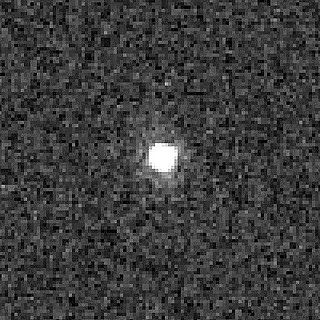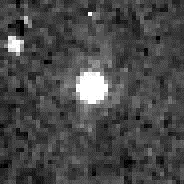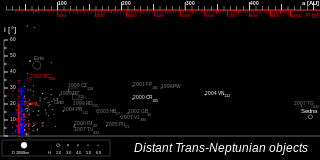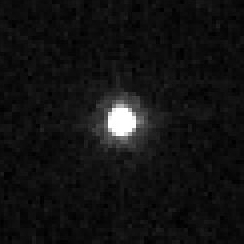Related Research Articles
(15874) 1996 TL66, provisional designation 1996 TL66, is a trans-Neptunian object of the scattered disc orbiting in the outermost region of the Solar System.

(90568) 2004 GV9 is a trans-Neptunian object that was discovered on April 13, 2004 by NEAT. It has been listed as a cubewano by the Minor Planet Center. It was discovered on 13 April 2004 by NEAT. It has been observed forty-seven times, with precovery images back to 1954. The object has an orbital period of 273.88 years. Its maximum possible distance from the Sun (aphelion) is 45.62 AU, and its closest (perihelion) is 38.7 AU, and currently 39.7 AU from he sun. It has an inclination of 21.9718, and eccentricity of 0.082.

(55565) 2002 AW197 is a classical, non-resonant trans-Neptunian object from the Kuiper belt in the outermost region of the Solar System, also known as a cubewano. With a likely diameter of at least 700 kilometers (430 miles), it is approximately tied with 2002 MS4 and 2013 FY27 (to within measurement uncertainties) as the largest unnamed object in the Solar System. It was discovered at Palomar Observatory in 2002.

(612911) 2004 XR190, nicknamed Buffy, is a trans-Neptunian object, classified as both a scattered disc object and a detached object, located in the outermost region of the Solar System. It was first observed on 11 December 2004, by astronomers with the Canada–France Ecliptic Plane Survey at the Mauna Kea Observatories, Hawaii, United States. It is the largest known highly inclined (> 45°) object. With a perihelion of 51 AU, it belongs to a small and poorly understood group of very distant objects with moderate eccentricities.
(119070) 2001 KP77, provisional designation:2001 KP77, is a resonant trans-Neptunian object in the Kuiper belt, a circumstellar disc located in the outermost region of the Solar System. It was discovered on 23 May 2001, by American astronomer Marc Buie at the Cerro Tololo Observatory in Chile. The object is locked in a 4:7 orbital resonance with Neptune. It has a red surface color and measures approximately 176 kilometers (110 miles) in diameter. As of 2021, it has not been named.

(145452) 2005 RN43, also written as (145452) 2005 RN43, is a classical Kuiper belt object. It has an estimated diameter of 679+55
−73 km. It was discovered by Andrew Becker, Andrew Puckett and Jeremy Kubica on 10 September 2005 at Apache Point Observatory in Sunspot, New Mexico. Brown estimates that it is possibly a dwarf planet.

(15875) 1996 TP66, provisional designation 1996 TP66, is a resonant trans-Neptunian object of the plutino population, located in the outermost region of the Solar System, approximately 154 kilometers (96 miles) in diameter. It was discovered on 11 October 1996, by astronomers Jane Luu, David C. Jewitt and Chad Trujillo at the Mauna Kea Observatories, Hawaii, in the United States. The very reddish RR-type with a highly eccentric orbit has been near its perihelion around the time of its discovery. This minor planet was numbered in 2000 and has since not been named. It is probably not a dwarf planet candidate.
(24835) 1995 SM55, provisional designation 1995 SM55, is a trans-Neptunian object and member of the Haumea family that resides in the Kuiper belt, located in the outermost region of the Solar System. It was discovered on 19 September 1995, by American astronomer Nichole Danzl of the Spacewatch program at Kitt Peak National Observatory near Tucson, Arizona, in the United States. It measures approximately 200 kilometers in diameter and was the second-brightest known object in the Kuiper belt, after Pluto, until 1996 TO66 was discovered.
(95625) 2002 GX32, also written as (95625) 2002 GX32, is a trans-Neptunian object that resides in the Kuiper belt. It has a 3:7 resonance with Neptune. It was discovered on April 8, 2002 by Marc W. Buie, Amy B. Jordan, and James L. Elliot.

Detached objects are a dynamical class of minor planets in the outer reaches of the Solar System and belong to the broader family of trans-Neptunian objects (TNOs). These objects have orbits whose points of closest approach to the Sun (perihelion) are sufficiently distant from the gravitational influence of Neptune that they are only moderately affected by Neptune and the other known planets: This makes them appear to be "detached" from the rest of the Solar System, except for their attraction to the Sun.
(131696) 2001 XT254, provisionally known as 2001 XT254, is a Kuiper belt object (KBO) that has a 3:7 resonance with Neptune.

471143 Dziewanna (provisional designation 2010 EK139) is a trans-Neptunian object in the scattered disc, orbiting the Sun in the outermost region of the Solar System.
(469306) 1999 CD158, provisional designation: 1999 CD158, is a trans-Neptunian object from the circumstellar disc of the Kuiper belt, located in the outermost region of the Solar System. The relatively bright hot classical Kuiper belt object measures approximately 310 kilometers (190 miles) in diameter. It was discovered on 10 February 1999, by American astronomers Jane Luu, David Jewitt and Chad Trujillo at Mauna Kea Observatories on the Big Island of Hawaii, United States.
(307463) 2002 VU130, prov. designation: 2002 VU130, is a trans-Neptunian object, located in the circumstellar disc of the Kuiper belt in the outermost region of the Solar System. The resonant trans-Neptunian object belongs to the population of plutinos and measures approximately 253 kilometers (160 miles) in diameter. It was discovered on 7 November 2002, by American astronomer Marc Buie at the Kitt Peak Observatory near Tucson, Arizona. The object has not been named yet.
(589683) 2010 RF43, provisionally designated: 2010 RF43, is a large trans-Neptunian object orbiting in the scattered disc in the outermost regions of the Solar System. The object was discovered on 9 September 2010, by American astronomers David Rabinowitz, Megan Schwamb and Suzanne Tourtellotte at ESO's La Silla Observatory in northern Chile.
2010 EU65 is a centaur, approximately 64 kilometers (40 miles) in diameter, orbiting the Sun in the outer Solar System. The object is also a promising Uranus horseshoe librator candidate. It was first observed on 13 March 2010, by American astronomers David Rabinowitz and Suzanne Tourtellotte, observing from Cerro Tololo and La Silla Observatory in Chile. As of 2021, it has neither been numbered nor named.

(82158) 2001 FP185, provisional designation 2001 FP185, is a highly eccentric trans-Neptunian object from the scattered disc in the outermost part of the Solar System, approximately 330 kilometers in diameter. It was discovered on 26 March 2001, by American astronomer Marc Buie at Kitt Peak National Observatory in Arizona, United States.

(416400) 2003 UZ117 is a trans-Neptunian object and suspected member of the Haumea family, located in the Kuiper belt in the outermost region of the Solar System. It was discovered on 24 October 2003, by astronomers of the Spacewatch survey project at Kitt Peak Observatory, Arizona. The object may also be a non-resonant cubewano.
(523635) 2010 DN93, provisional designation 2010 DN93, is a trans-Neptunian object from in the scattered disc located in the outermost region of the Solar System. It was discovered on 26 February 2010, by astronomers with the Pan-STARRS survey at Haleakala Observatory on the island of Maui, Hawaii, in the United States. Assuming a low albedo, the object is estimated at approximately 490 kilometers (300 miles) in diameter. It was numbered in 2018 and remains unnamed.
References
- 1 2 3 4 "JPL Small-Body Database Browser: 120348 (2004 TY364)" (2005-09-01 last obs; arc: 22.13 years). Retrieved 7 April 2016.
- 1 2 Nomenclature in the outer Solar System
- 1 2 Marc W. Buie. "Orbit Fit and Astrometric record for 120348" (last observation: 2005-08-31 using 20 of 21 observations over 22 years). SwRI (Space Science Department). Retrieved 2014-11-13.
- ↑ "MPEC 2010-S44 :Distant Minor Planets (2010 OCT. 11.0 TT)". IAU Minor Planet Center. 2010-09-25. Retrieved 2014-11-16.
- ↑ JPL Horizons Observer Location: @sun (Perihelion occurs when deldot changes from negative to positive. Uncertainty in time of perihelion is 3-sigma.)
- 1 2 3 Lellouch, E.; Santos-Sanz, P.; Lacerda, P.; Mommert, M.; Duffard, R.; Ortiz, J. L.; Müller, T. G.; Fornasier, S.; Stansberry, J.; Kiss, Cs.; Vilenius, E.; Mueller, M.; Peixinho, N.; Moreno, R.; Groussin, O.; Delsanti, A.; Harris, A. W. (September 2013). ""TNOs are Cool": A survey of the trans-Neptunian region. IX. Thermal properties of Kuiper belt objects and Centaurs from combined Herschel and Spitzer observations" (PDF). Astronomy & Astrophysics. 557: A60. arXiv: 1202.3657 . Bibcode:2013A&A...557A..60L. doi:10.1051/0004-6361/201322047 . Retrieved 7 November 2014.
- 1 2 "AstDys (120348) 2004TY364 Ephemerides". Department of Mathematics, University of Pisa, Italy. Retrieved 2009-12-10.
- ↑ "List Of Centaurs and Scattered-Disk Objects". Minor Planet Center. Retrieved 2014-11-13.
- ↑ Gonzalo Tancredi & Sofía Favre (13 October 2008). "Dwarf Planet & Plutoid Headquarters". Portal Uruguayo de Astronomía. Retrieved 2010-09-22. (Which are the dwarfs in the Solar System?)

